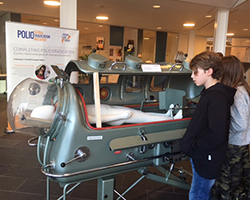World Polio Day celebrates history in the making

WHO
Thanks to the widespread use of safe and effective vaccines, poliomyelitis (polio) is expected to become the second human disease ever to be eradicated (after smallpox). Only 20 cases of wild poliovirus have been detected so far this year in the 3 remaining endemic countries (Afghanistan, Nigeria and Pakistan). World Polio Day, on 24 October, celebrates this progress and the people who make it possible by getting their own children vaccinated and those working to reach every last child until no child’s future is threatened by the crippling impact of this disease.
“Even though we don’t have polio in the WHO European Region, it is important to keep vaccinating until we have rid this disease from every corner of our planet. As long as polio is circulating somewhere in the world, everyone who is not immunized is at risk,” says Dr Patrick O’Connor, Team Lead, Accelerated Disease Control, WHO/Europe.
Global Polio Eradication Initiative turns 30
Before the first vaccine against polio was introduced in 1955, polio was a widely feared disease that infected most people in childhood, causing paralysis in approximately 1 in 200 cases. By the early 1980s, new cases had fallen but still hundreds of children were paralysed worldwide every day. In 1988, the World Health Assembly formally resolved to eradicate polio, and the Global Polio Eradication Initiative (GPEI) was born.
Since then, more than 2.5 billion children have been immunized against polio, thanks to the cooperation of more than 200 countries and 20 million volunteers. Of the 3 types of wild polioviruses, the last case of type 2 was reported in 1999 and its eradication was declared in September 2015. No cases of type 3 polio have been detected since November 2012.
However, tackling the remaining 0.01% of polio cases has proven to be difficult. Conflict, political instability, hard-to-reach populations, and poor health infrastructure continue to pose challenges to eradicating the disease. Until the last chains of circulation in endemic areas have been interrupted, importation of the virus into countries that have already eradicated it remains a threat.
Status and preparedness in the European Region
The European Region was declared polio free in 2002. This status is reviewed every year by the independent European Regional Commission for the Certification of Poliomyelitis Eradication (RCC). Based on country reports, the RCC considers whether:
- the virus may have entered or circulated in the Region
- population immunity is sufficient to prevent ongoing infection
- the Region is prepared to respond if a case were detected.
With global eradication approaching, an additional focus for the Region is on the safe containment or destruction of polioviruses currently held in research and vaccine manufacturing facilities.
In its May 2018 report, the RCC expressed concern that vaccination coverage is in decline in some countries. The RCC identified 3 countries at high risk for the possible spread of poliovirus if the virus were to be imported or emerge (Bosnia and Herzegovina, Romania and Ukraine) and 21 countries considered to be at intermediate risk.
The RCC urged all countries to ensure high routine vaccination coverage, high-quality disease surveillance and adherence to WHO poliovirus containment requirements.
What is polio?
Polio is a crippling and potentially fatal infectious disease that results from infection with any of the 3 related poliovirus types, which are members of the enterovirus (picornavirus) family.
In most cases the virus causes no or only flu-like symptoms. However, in 1 out of 200 cases among children or adults, it invades the nervous system, destroying nerve cells and causing the affected muscles to lose their function – a condition known as acute flaccid paralysis (AFP). If the virus attacks the motor neurons of the brain stem it reduces breathing capacity and may cause difficulty in swallowing and speaking. Some people recover fully, but others develop permanent disability. Polio survivors can experience increasing muscle weakness and other symptoms decades after recovery, a condition called post-polio syndrome. Thousands of people in the
European Region today live with the effects of polio and post-polio syndrome.
There is no cure for polio, but it can be prevented through immunization. The polio vaccine, given multiple times in the form of drops or injections, almost always protects a child for life.
The strategy to eradicate polio is therefore to immunize every child to prevent infection and reintroduction of the virus everywhere in the world. This work must continue until the entire world is certified polio-free.



